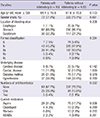1. Seo YS, Kim YH, Ahn SH, Yu SK, Baik SK, Choi SK, Heo J, Hahn T, Yoo TW, Cho SH, et al. Clinical features and treatment outcomes of upper gastrointestinal bleeding in patients with cirrhosis. J Korean Med Sci. 2008; 23:635–643.
2. Chiu PW, Joeng HK, Choi CL, Kwong KH, Ng EK, Lam SH. Predictors of peptic ulcer rebleeding after scheduled second endoscopy: clinical or endoscopic factors? Endoscopy. 2006; 38:726–729.
3. Travis AC, Wasan SK, Saltzman JR. Model to predict rebleeding following endoscopic therapy for non-variceal upper gastrointestinal hemorrhage. J Gastroenterol Hepatol. 2008; 23:1505–1510.
4. Suk KT, Kim HS, Lee CS, Lee IY, Kim MY, Kim JW, Baik SK, Kwon SO, Lee DK, Ham YL. Clinical outcomes and risk factors of rebleeding following endoscopic therapy for nonvariceal upper gastrointestinal hemorrhage. Clin Endosc. 2011; 44:93–100.
5. Suehiro T, Yakeishi Y, Sakai F, Matsuzaki K, Sanefuji K, Toyokawa T, Shioshita K, Sugie Y, Okudaira Y, Kano T, et al. Gastrointestinal bleeding associated with antithrombotic therapy in the elderly in Japan. Hepatogastroenterology. 2012; 59:774–777.
6. Sostres C, Lanas A. Gastrointestinal effects of aspirin. Nat Rev Gastroenterol Hepatol. 2011; 8:385–394.
7. Hylek EM. Complications of oral anticoagulant therapy: bleeding and nonbleeding, rates and risk factors. Semin Vasc Med. 2003; 3:271–278.
8. Chung IK, Lee DH, Kim HU, Sung IK, Kim JH. Korean College of Helicobacter and Upper Gastrointestinal Research. Korean Association of Gastroenterology. Guidelines of treatment for bleeding peptic ulcer disease. Korean J Gastroenterol. 2009; 54:298–308.
9. Tang SJ, Lee SY, Hynan LS, Yan J, Riley FC, Armstrong L, Rodriguez-Frias E, Xu L, Pruna E, Lara LF, et al. Endoscopic hemostasis in nonvariceal upper gastrointestinal bleeding: comparison of physician practice in the East and the West. Dig Dis Sci. 2009; 54:2418–2426.
10. Lee SY, Tang SJ, Rockey DC, Weinstein D, Lara L, Sreenarasimhaiah J, Choi KW. Korean Association for the Study of Intestinal Disease. Managing anticoagulation and antiplatelet medications in GI endoscopy: a survey comparing the East and the West. Gastrointest Endosc. 2008; 67:1076–1081.
11. Yamamoto T, Sanaka M, Nagasawa K, Abe K, Fukami M, Nakayama S, Tsuchiya A, Ishii T, Kuyama Y. Gastroduodenal mucosal injury in patients on antiplatelet therapy. Thromb Res. 2007; 120:465–469.
12. Lee JK, Kang HW, Kim SG, Kim JS, Jung HC. Risks related with withholding and resuming anticoagulation in patients with non-variceal upper gastrointestinal bleeding while on warfarin therapy. Int J Clin Pract. 2012; 66:64–68.
13. Wolf AT, Wasan SK, Saltzman JR. Impact of anticoagulation on rebleeding following endoscopic therapy for nonvariceal upper gastrointestinal hemorrhage. Am J Gastroenterol. 2007; 102:290–296.
14. Chan FK, Ching JY, Hung LC, Wong VW, Leung VK, Kung NN, Hui AJ, Wu JC, Leung WK, Lee VW, et al. Clopidogrel versus aspirin and esomeprazole to prevent recurrent ulcer bleeding. N Engl J Med. 2005; 352:238–244.
15. Barkun AN, Bardou M, Kuipers EJ, Sung J, Hunt RH, Martel M, Sinclair P. International Consensus Upper Gastrointestinal Bleeding Conference Group. International consensus recommendations on the management of patients with nonvariceal upper gastrointestinal bleeding. Ann Intern Med. 2010; 152:101–113.
16. Endo M, Higuchi M, Chiba T, Suzuki K, Inoue Y. Present state of endoscopic hemostasis for nonvariceal upper gastrointestinal bleeding. Dig Endosc. 2010; 22:S31–S34.
17. Kawamura T, Yasuda K, Morikawa S, Itonaga M, Nakajima M. Current status of endoscopic management for nonvariceal upper gastrointestinal bleeding. Dig Endosc. 2010; 22:S26–S30.
18. Maggio D, Barkun AN, Martel M, Elouali S, Gralnek IM. Reason Investigators. Predictors of early rebleeding after endoscopic therapy in patients with nonvariceal upper gastrointestinal bleeding secondary to high-risk lesions. Can J Gastroenterol. 2013; 27:454–458.
19. Restellini S, Kherad O, Jairath V, Martel M, Barkun AN. Red blood cell transfusion is associated with increased rebleeding in patients with nonvariceal upper gastrointestinal bleeding. Aliment Pharmacol Ther. 2013; 37:316–322.











 PDF
PDF ePub
ePub Citation
Citation Print
Print





 XML Download
XML Download